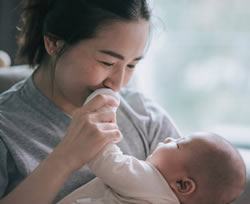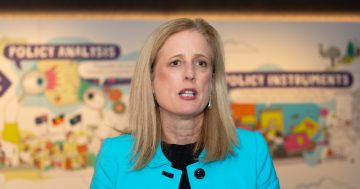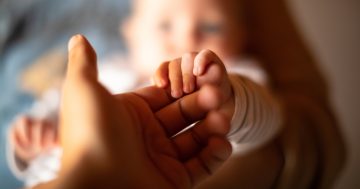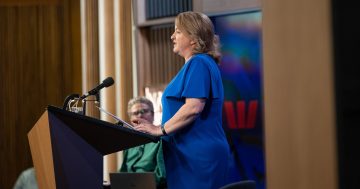Chrys Stevenson* says experts believe Australia’s current paid parental leave scheme isn’t serving parents as well as it should.
 Thinking of parenthood in the 1950s conjures a picture of a perfectly coiffed wife, cherubic baby in arms, cheerily waving goodbye to her husband – the gallant breadwinner – as he heads off to work.
Thinking of parenthood in the 1950s conjures a picture of a perfectly coiffed wife, cherubic baby in arms, cheerily waving goodbye to her husband – the gallant breadwinner – as he heads off to work.
If that stereotype was ever accurate, it certainly doesn’t reflect parenthood and gender roles in 2022.
But, according to Professor Marian Baird, professor of gender and employment relations at the University of Sydney Business School, this 1950s mindset permeates our Federal government’s paid parental leave legislation.
On a recent episode of the Academy of Social Sciences’ Seriously Social podcast, Professor Baird explained why this outdated legislation has failed to keep pace with changing community attitudes and expectations and still, for the most part, leaves women holding the baby.
Introduced by the Rudd Government in 2010, the Federal Government’s paid parental leave scheme provides parental leave of up to 18 weeks at the national minimum wage to eligible “primary carers.”
A 2012 amendment – specified as “Dad and Partner Pay” – added two weeks paid leave for “secondary carers.”
Obtaining paid parental leave was a hard-won victory for women.
Women started lobbying for maternity leave in 1919.
Sweden was the first country to introduce paid leave for both parents in 1974.
In Australia, the Whitlam government introduced paid maternity leave for public servants in 1973, but it took another 38 years for that benefit to be extended to all Australian women and their partners.
When the Rudd/Gillard government’s legislation passed in 2011, we were one of only two developed nations in the world without a national paid parental leave scheme.
Today, Professor Baird told Seriously Social host, Ginger Gorman, that legislation is not serving Australian parents as well as it should.
Last year, as the Paid Parental Leave Act reached its tenth anniversary, Professor Baird and her colleagues undertook a study to assess the extent to which Australia’s Paid Parental Leave Act meets current community needs and expectations.
They found that amendments to the Act over the past decade have had a small, and generally positive impact, but the Act still fails to adequately promote gender equity in parental childcare.
In 2022, this falls far short of community expectations.
In their study, says Professor Baird, “… we found that young men with a child, or married and expecting a child, were willing and wanting to share the care almost as equally as the female partners were.”
Conversely, she says, “Our research over 20 years has shown that women in Australia want to be at work, and they want to look after their children, they do want to do both.”
The attitudes implicit in the terminology of Australia’s Paid Parental Leave Act don’t adequately reflect these professional and parental aspirations.
The Act assumes that, in families, the mother is the “primary carer”, while the other “Dad or Partner” is a “secondary carer.” According to Professor Baird, “…this notion of a ‘secondary carer’ sets up an idea that the father is usually not as important in the care of the new baby.”
Yet, despite men telling Professor Baird and her team that they wanted to share equally in parenting their young children, only about 25 per cent of eligible “secondary carers” actually take up the government’s 14 day entitlement.
The explanation, says Professor Baird, is that economic, structural and cultural barriers prevent men from taking advantage of even this small benefit.
She explains that, in working families which normally rely on two incomes, having even one partner at home on a benefit equivalent to “minimum wage” may result in considerable financial hardship.
There is a financial disincentive for men to take paid parental leave.
Compounding this, both structurally and culturally, many Australian workplaces actively discourage men from taking extended leave in order to care for their children.
And yet, in Finland, Professor Baird reminded Seriously Social listeners, “it’s absolutely standard for dads to take a year off to care for their children.” In fact, the Finnish government offers incentives for them to do so.
Despite the current budgetary climate, there are some encouraging signs that a more responsive ALP government may institute much needed reforms.
The government is currently considering a proposal to extend paid parental leave from 18 to 20 weeks, and to make it available for both parents to share equally.
But, Professor Baird warns that gender equity in the uptake of paid parental leave is unlikely to be achieved if payments remain tied to the current, low, minimum wage.
Legislative change must focus on increasing the payment amount, allowing fathers to take extended paid leave, and provide incentives for them to claim these benefits.
Of course, there will be political resistance to the push for a more liberal paid parental leave scheme, but Professor Baird insists the cost of a more generous scheme will be a wise investment in Australia’s future.
Women need to be encouraged to have children; Australia’s economy depends on population growth to replenish the labor market.
Ageing populations also mean higher health and welfare costs.
A scheme which effectively functions to push women out of the workforce and into the role of ‘primary carer’ may also have devastating long-term effects on women’s financial stability.
And if the human cost is not sufficient argument, this inevitably flows on to effect the national economy.
When women are forced to withdraw from the labour market in order to care for children, it not only affects their income for the period they are absent from work, it affects their long-term career prospects, their superannuation, their future potential earnings and, ultimately, their health and welfare status.
This has an economic roll-on effect in terms of welfare payments and lost productivity.
Also speaking on this episode of the Seriously Social podcast, Sam Page, CEO of Early Childhood Australia, strongly supported Professor Baird’s arguments in favour of a more generous and equitable paid parental leave scheme.
She explains:
“In those early months, a secure attachment between the child and its parents or carers immediately following birth is really critical for long term health and well-being.
“When we get that right, we strengthen families.
“We know those children are likely to have less health and mental health issues, long term, more likely to make a smooth transition into education and more likely to continue and finish their education.
“And that’s in everybody’s interest.
“Everybody benefits, not just the child themselves, not just the family, but the whole of society; and that pays dividends.”
For Australian women, the recent change of government feels like we’ve finally stepped out of a 1950s time-warp and back into the 21st century.
The Paid Parental Leave Act, with its out-dated notions of parental gender-roles, and barriers to equitable parenting, needs a radical overhaul – not just for women, but for everyone’s benefit.
*Chrys Stevenson is a freelance writer and researcher.
This article first appeared at broadagenda.com.au/












